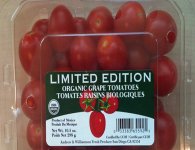David Baxter PhD
Late Founder
Organic grape tomatoes recalled for salmonella
CBC News
Sep 30, 2011

The recalled tomatoes were distributed in British Columbia and Ontario and possibly in other provinces.
People shouldn't eat certain organic grape tomatoes because they may be contaminated with salmonella, federal food officials say.
The Canadian Food Inspection Agency warned people not to consume Organic Grape Tomatoes, sold in plastic clam shell containers and supplied by Andrew & Williamson Fresh Produce of San Diego. The affected product is Limited Edition 0.5 oz (298 g) organic grape tomatoes. The label says Product of Mexico and bears the code 0 33383 65592 5. The tomatoes were distributed in British Columbia and Ontario and possibly in other provinces.
No illnesses associated with the products have been reported.
Food contaminated with salmonella may not look or smell spoiled, but eating these foods may cause illness. In young children, the elderly and people with weakened immune systems, the salmonella may cause serious and sometimes deadly infections, CFIA said. In otherwise healthy people, the illness may lead to short-term symptoms such as high fever, severe headache, vomiting, nausea, abdominal pain and diarrhea. Long-term complications may include severe arthritis.
The importers are voluntarily recalling the affected product from the marketplace.
CBC News
Sep 30, 2011

The recalled tomatoes were distributed in British Columbia and Ontario and possibly in other provinces.
People shouldn't eat certain organic grape tomatoes because they may be contaminated with salmonella, federal food officials say.
The Canadian Food Inspection Agency warned people not to consume Organic Grape Tomatoes, sold in plastic clam shell containers and supplied by Andrew & Williamson Fresh Produce of San Diego. The affected product is Limited Edition 0.5 oz (298 g) organic grape tomatoes. The label says Product of Mexico and bears the code 0 33383 65592 5. The tomatoes were distributed in British Columbia and Ontario and possibly in other provinces.
No illnesses associated with the products have been reported.
Food contaminated with salmonella may not look or smell spoiled, but eating these foods may cause illness. In young children, the elderly and people with weakened immune systems, the salmonella may cause serious and sometimes deadly infections, CFIA said. In otherwise healthy people, the illness may lead to short-term symptoms such as high fever, severe headache, vomiting, nausea, abdominal pain and diarrhea. Long-term complications may include severe arthritis.
The importers are voluntarily recalling the affected product from the marketplace.
